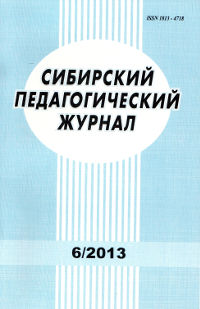The Сombination of the “Flipped Classroom” Method with the Name Method in Chinese Lessons
1. Ding, Anqi et al. 2013. The general program of international teaching of Chinese. Beijing: Beijing University Publ., 230 p. (In Chinese)
2. Dictionary of terms and concepts of digital didactics. Available at: https://firo.ranepa. ru/ files/docs / EP/Slovar_cifrovoj_didaktiki. (accessed: 06.08.2021). (In Russian)
3. Sims, A., Bergmann, J. Flip your classroom: https://www.rcboe.org/cms/lib/GA01903614/Centricity/Domain/15504/Flip_Yo... (accessed: 26.09.2022) (In English)
4. Lu Bo, 2015. A study on the application of the concept of the game in learning in an inverted classroom. Learning a New Curriculum (Part 2), рp. 176–177. (In Chinese)
5. Li Ying, Dai Xinlai, Zhang Chengning, 2019. A study on the development of interactive learning activities in the classroom, based on the game training. The magazine ʺSoftware Manual (educational technologies)ʺ, no. 9, рp. 46–47. (In Chinese)
6. Wang Bencheng, Song Lili, 2014. Training mode ʺInverted classʺ. Research on the educational curriculum, рp. 41–42. (In Chinese)
7. Dan, Dee, 2016. A review of research on the application of the inverted classroom model in teaching English at universities. The World of Foreign Languages Magazine, iss. 04, рp. 90–91. (In Chinese)
8. Zhang Jinlei, Zhang Baohui, 2013. A study on the application of game-based learning concepts in learning in an inverted classroom. Journal of Distance Education, no. 1, рp. 73–74. (In Chinese)
9. Li Zhanjie, 2014. A study on the application of game-based learning concepts in learning in an inverted classroom. Electronic Production Magazine, no. 14, рp. 168–169. (In Chinese)
10. Liang, Wei, 2013. Building an inverted classroom environment based on games. Journal “Educational Information Technologies”, no. 4, рp. 12–13. (In Chinese)
11. Chen, Huan, 2016. A study of the design of educational games based on an inverted classroom. Intellect Magazine, no. 31, рp. 184–185. (In Chinese)
12. Zhang Jinlei, Wang Ying, Zhang Baohui, 2012. The study of the inverted model of learning in the classroom. Journal “Bulletin of Distance Education”, no. 4, рp. 46–47. (In Chinese)
13. Chen Zhong, 2014. Development and practice of learning in an inverted classroom based on game-based learning. Journal of Higher Education, no. 4, рp. 81–82. (In Chinese)
14. Bai Didi, 2014. Research on the application of the learning model “Flipped classroom,” in teaching Chinese as a foreign language. Journal “Modern Chinese (Language Research Publication)”, no. 3, рp. 95–96. (In Chinese)
15. Li Zhenhua, Hu Yuliang, Lu Xiangxiong, 2018. Inverted classroom teaching based on the concept of game-based learning. Journal “Experimental Technologies and Management”, no. 6, рp. 163–164. (In Chinese)
16. Zhang Yan, 2017. A study of the application of game-based learning concepts in inverted classrooms. Science, Education and Culture (first edition), no. 7, рp. 47–48. (In Chinese)
17. Yu Qibin, 2018. A study of the strategy of game-based learning concepts when learning in an inverted classroom. Software Manual (Educational Technologies), no. 2, рp. 24–25. (In Chinese)
18. Zeng Jian, 2006. The use of games in the acquisition of a second language and teaching. Journal of the Hubei Institute of Adult Education, no. 2, рp. 61–62. (In Chinese)
19. Luo Gunyin et al., 2016. A study on the application of the concept of co-education when teaching in an inverted classroom. Journal of Chinese Higher Medical Education, no. 6, рp. 79–80. (In Chinese)
20. Shi Tao, 2019. The application of the inverted mode of learning in the classroom at the game level design courses. Decoration Magazine, no. 10, рp. 132–133. (In Chinese)




